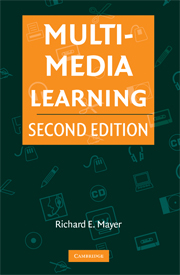Book contents
- Frontmatter
- Contents
- PREFACE
- SECTION I INTRODUCTION TO MULTIMEDIA LEARNING
- SECTION II PRINCIPLES FOR REDUCING EXTRANEOUS PROCESSING IN MULTIMEDIA LEARNING
- SECTION III Principles for Managing Essential Processing in Multimedia Learning
- SECTION IV PRINCIPLES FOR FOSTERING GENERATIVE PROCESSING IN MULTIMEDIA LEARNING
- SECTION V CONCLUSION
- REFERENCES
- AUTHOR INDEX
- SUBJECT INDEX
SECTION II - PRINCIPLES FOR REDUCING EXTRANEOUS PROCESSING IN MULTIMEDIA LEARNING
- Frontmatter
- Contents
- PREFACE
- SECTION I INTRODUCTION TO MULTIMEDIA LEARNING
- SECTION II PRINCIPLES FOR REDUCING EXTRANEOUS PROCESSING IN MULTIMEDIA LEARNING
- SECTION III Principles for Managing Essential Processing in Multimedia Learning
- SECTION IV PRINCIPLES FOR FOSTERING GENERATIVE PROCESSING IN MULTIMEDIA LEARNING
- SECTION V CONCLUSION
- REFERENCES
- AUTHOR INDEX
- SUBJECT INDEX
Summary
Consider the following situation. You are interested in how lightning storms develop, so you go to an online encyclopedia and click on a movie icon labeled “How Lightning Works.” You watch a three-minute narrated animation that explains the steps in lightning formation. The lesson includes many interesting facts about lightning, such as the fact that each year 150 Americans die from being struck by lightning, and has many interesting video clips, such as ten-second segments showing various lightning storms. To increase your enjoyment, the lesson has an instrumental music loop playing in the background. Your attention is drawn to the many interesting features of the lesson, such as the interesting facts and video clips, so you do not pay much attention to some of the essential information about the steps in lightning formation. On a subsequent retention test, you can remember parts of some of the sentences about lightning formation, and on a transfer test, you are not able to apply what was presented to solving new problems.
What is extraneous processing overload? This situation is an example of extraneous processing overload – that is, a situation in which the cognitive processing of extraneous material in the lesson is so demanding that there is little or no remaining cognitive capacity to engage in essential or generative processing. Extraneous processing overload is likely to occur when the lesson contains attention-grabbing extraneous material or when the lesson is designed in a confusing way.
- Type
- Chapter
- Information
- Multimedia Learning , pp. 85 - 88Publisher: Cambridge University PressPrint publication year: 2009
- 1
- Cited by



